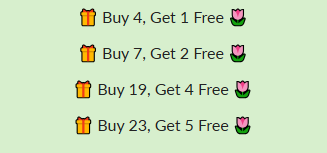Pepper, Sweet, Great Stuff Hybrid
Date prisa, la oferta finaliza en
 Non-GMO Seeds
Non-GMO Seeds
 100% Organic Seeds
100% Organic Seeds
 Money Back if Seeds Don’t Sprout
Money Back if Seeds Don’t Sprout
Comprados juntos frecuentemente
Description
The right stuffer!Produces excellent yields under varied conditions. Days to maturity are from time plants are set in garden. For transplants add 8-10 weeks. Space plants 18-24" apart.
How to Grow
Keep weeds under control during the growing season. Weeds compete with plants for water, space and nutrients, so control them by either cultivating often or use a mulch to prevent their seeds from germinating.
Mulches also help retain soil moisture and maintain even soil temperatures. This is especially important for peppers as their roots may be easily damaged when weeding, and this can lead to blossom end rot.
Keep plants well-watered during the growing season, especially during dry spells. Plants need about 1-2" of rain per week during the growing season. Use a rain gauge to check to see if you need to add water. It's best to water with a drip or trickle system that delivers water at low pressure at the soil level. If you water with overhead sprinklers, water early in the day so the foliage has time to dry off before evening, to minimize disease problems. Keep the soil moist but not saturated.
Note that hot peppers tend to be hotter when they have less water and fertilizer. If they receive plenty of water and fertilizer they may be more mild than expected.
Monitor for pests and diseases. Check with your local Cooperative Extension Service for pest controls recommended for your area.
Try planting pepper plants near tomatoes, parsley, basil, and carrots in your home vegetable garden. Don't plant them near fennel or kohlrabi. Peppers are very colorful when in full fruit and combine well with green herbs, okra, beans and cucumber fences in the garden bed.
Tips
Like cucumbers and summer squash, peppers are usually harvested at an immature stage. The traditional bell pepper, for example, is harvested green, even though most varieties will mature red, orange, or yellow. Peppers may be harvested at any stage, but their flavor doesn’t fully develop until maturity. Fully ripe peppers in multi-colors are delightful in the garden as well as in salads.
Cut the fruit from the plant with a sharp knife or pruners leaving a small part of the stem attached.
Sweet bell, pimento and cherry peppers are delicious eaten green but are sweeter and higher in vitamins if allowed to turn bright red before harvest. Some varieties are yellow at maturity or may mature from green through yellow and red.
Hot peppers may be harvested at any stage. Anaheim is usually picked green and cayenne types red.
Bell peppers may be chopped and quick frozen for use in many recipes; sweet cherry and banana peppers and hot cherry peppers are perfect for pickling.
A popular and trouble-free way to store hot peppers is to dry them. String mature red peppers by piercing the stem with a needle and heavy thread. Hang the string in a warm, dry, airy place (not in the sun!) to dry. They can make a colorful kitchen accent. Pull a pepper from the string when you need one. Hot peppers remain hot even after they are dried. Remember that in recipes a little hot pepper can go a long way.
Please note that hot peppers can burn sensitive skin on contact and fumes from grinding or cooking them can irritate the lungs and eyes. When working with hot peppers use rubber gloves and wash your hands before touching your face or eyes.
Second:💰 Money-Back Guarantee: If you have any quality problems with the product within 30 days of purchase, we will gladly issue out a replacement or refund.
Third:✉️ Customer Support: We have a team of live reps ready to help and answer any questions you have within a 8-hour time frame, 5 days a week.
Fourth:🔒 Safe & Secure Checkouts: We use state-of-the-art SSL Secure encryption to keep your personal and financial information 100% protected.
Every shopping experience is a new experience full of expectations. If there are any problems with the seeds you received or the logistics process, please contact us by email first. We promise to follow up and handle it for you as soon as possible: whether you need to resend the goods or want a refund service, we will respond as quickly as possible. Your satisfaction is our primary pursuit!






